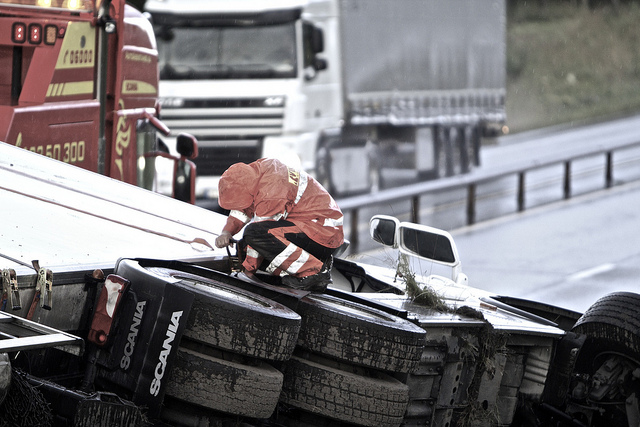Rollovers happen every day in the trucking industry, but they don't have to. Read on to learn about three major rollover myths, the three main causes of rollovers and what you can do to prevent them from happening to you.
Three Common Rollover Myths
Myth #1: Poor driving conditions lead to most rollovers
Facts:
-
Less than 4 percent of single vehicle rollovers are actually caused by roadway and environmental factors.
-
Over half (56 percent) happen on straight roads - not on curves or ramps.
-
Approximately two-thirds of rollovers occur in daylight rather than in the dark.
-
Ninety-three percent of rollovers occur on dry roads.

Myth #2: The vast majority of rollovers are caused by reckless maneuvers and excessive speeding.
Facts:
-
Speeding certainly increases the risk of rollover accidents, but excessive speed is a contributing factor in less than half of all rollovers. That means that more than 50 percent of rollovers are due to other factors. Drivers often assume their rollover risk is negligible as long as they avoid excessive speeds. That is simply not the case. Avoiding excessive speeds is an important first step in rollover prevention, but there are a host of other factors, including driver fatigue and inattention that can also cause accidents.
-
Evasive maneuvers are a factor in only a small percentage (5 to 10 percent) of rollovers.
Myth #3: Rollovers only happen to inexperienced drivers.
Facts:
-
Approximately 66 percent of rollovers involve drivers with more than 10 years of driving experience.
-
Most rollovers occur among drivers between the ages of 25 and 55.
The Three Main Causes of Rollovers
So, if most rollovers aren't caused by external conditions, speed or inexperience, what does cause them?
-
Driver error is responsible for over three-quarters of all rollovers. Rollovers can happen to anyone at any time, so drivers can never be too comfortable behind the wheel. Over 90 percent of the time, the rollover is not the "first" event - in other words, some other dangerous event occurs before the rollover. It maight be drowsiness or inattention, which together contribute to about 20 percent of rollovers, with running off the road due to inattention being the leading cause of serious crashes. The event might be a driver drifting over into a soft shoulder, riding up over a curb or incorrectly making a turn at an intersection. Attentive driving can prevent most rollovers.
-
Vehicle condition plays a role in some rollovers. In a recent Federal Motor Carrier Safety Administration study, 54 percent of the vehicles involved in a rollover accident had a brake defect of some sort.
-
Load size is also a factor in some rollovers. More than 90 percent of cargo tank rollovers occur while carrying partial loads, so if you are hauling liquids, it's important to understand the "slosh and surge" effect of liquid loads. "Slosh" refers to liquid running up the sides of a tanker, which changes the tanker's center of gravity, and "surge" refers to liquid shifting from front to back and then back to front when accelerating or braking.
How You Can Prevent Rollovers
Since a large majority of rollovers are caused by driver error, most crashes are preventable. Here are several ways you can prevent a rollover and get to your destination safely:
-
Slow it down. Obey the speed limits and take it slow around corners.
-
Stay alert. Falling asleep at the wheel or driving while fatigued is unacceptable. Turning up the radio or rolling down your windows are not effective ways to keep you alert. Hours-of-Service regulations are in place to prevent fatigue-related accidents.
-
Put down the cellphone. Not only is it extremely dangerous to text while driving, it is also illegal for truckers to do so.
-
Ensure your truck is mechanically sound before your trip. You don't want to be involved in a rollover or other accident because your brakes weren't properly checked before a trip.
-
Understand the design and performance of the type of truck you will be driving. For example, tankers handle differently than reefers or flatbeds.
-
Always make sure loads are tied down properly. Shifting loads can easily lead to a rollover.
Ultimately, many of the factors that can cause a rollover crash are entirely under the driver's control. Always remember - deadlines are important, but safety is your number one priority.
Originally published by TrueNorth Companies.
Image Source -
https://www.flickr.com/photos/jkfjellestad/